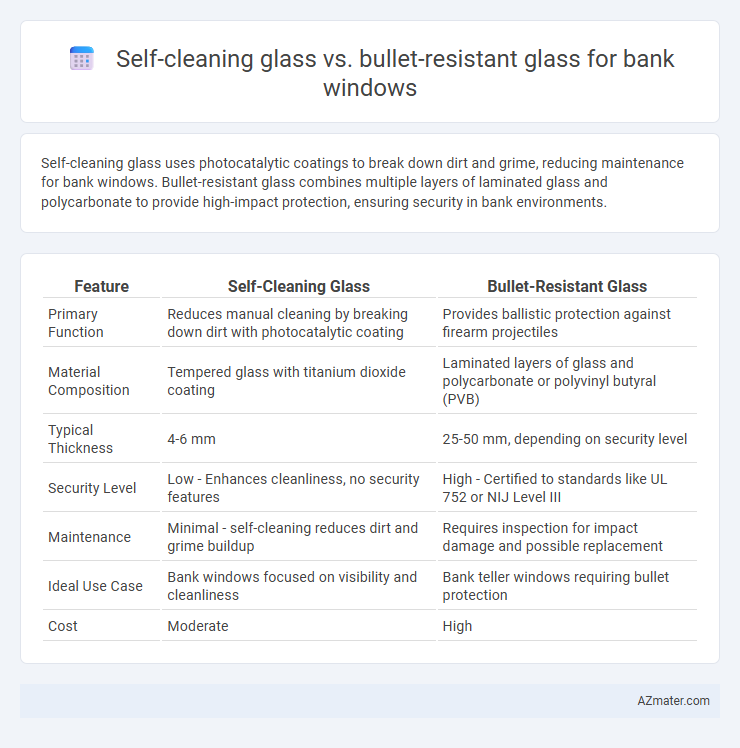Self-cleaning glass uses photocatalytic coatings to break down dirt and grime, reducing maintenance for bank windows. Bullet-resistant glass combines multiple layers of laminated glass and polycarbonate to provide high-impact protection, ensuring security in bank environments.
Table of Comparison
| Feature | Self-Cleaning Glass | Bullet-Resistant Glass |
|---|---|---|
| Primary Function | Reduces manual cleaning by breaking down dirt with photocatalytic coating | Provides ballistic protection against firearm projectiles |
| Material Composition | Tempered glass with titanium dioxide coating | Laminated layers of glass and polycarbonate or polyvinyl butyral (PVB) |
| Typical Thickness | 4-6 mm | 25-50 mm, depending on security level |
| Security Level | Low - Enhances cleanliness, no security features | High - Certified to standards like UL 752 or NIJ Level III |
| Maintenance | Minimal - self-cleaning reduces dirt and grime buildup | Requires inspection for impact damage and possible replacement |
| Ideal Use Case | Bank windows focused on visibility and cleanliness | Bank teller windows requiring bullet protection |
| Cost | Moderate | High |
Introduction to Bank Window Technologies
Bank window technologies prioritize security, clarity, and maintenance efficiency to protect assets and provide clear visibility. Self-cleaning glass incorporates titanium dioxide coatings that use natural sunlight and rain to break down organic dirt, reducing manual cleaning requirements. Bullet-resistant glass consists of layered polycarbonate and laminated glass, engineered to absorb and dissipate ballistic impacts, ensuring enhanced safety against violent threats.
Overview of Self-Cleaning Glass
Self-cleaning glass for bank windows features a special coating that breaks down organic dirt and allows rainwater to rinse away debris, reducing maintenance costs and improving visibility. This glass utilizes photocatalytic and hydrophilic properties to maintain clarity without frequent manual cleaning. While it enhances cleanliness and aesthetics, it does not provide the ballistic protection offered by bullet-resistant glass.
Overview of Bullet-Resistant Glass
Bullet-resistant glass used in bank windows consists of multiple layers of laminated glass and polycarbonate materials engineered to absorb and disperse the energy from ballistic impacts. This glass is rated based on standards such as UL 752 or NIJ, indicating its ability to resist various levels of firearm threats. Unlike self-cleaning glass, bullet-resistant glass prioritizes security and protection, combining transparency with high-impact resistance to safeguard bank personnel and assets.
Key Differences Between Self-Cleaning and Bullet-Resistant Glass
Self-cleaning glass for bank windows utilizes a special coating that breaks down organic dirt with sunlight and washes it away with rain, reducing maintenance efforts and keeping the glass clear. Bullet-resistant glass is engineered with multiple layers of laminated polycarbonate and glass to absorb and disperse the energy of high-velocity projectiles, providing essential security against armed attacks. The primary difference lies in their function: self-cleaning glass enhances cleanliness and reduces upkeep, whereas bullet-resistant glass prioritizes safety and protection from ballistic threats.
Safety and Security Benefits for Banks
Self-cleaning glass for bank windows reduces maintenance costs and enhances visibility, promoting a cleaner environment that supports security personnel's surveillance efforts. Bullet-resistant glass offers critical impact protection, safeguarding bank employees and assets against armed attacks and forced entry attempts. Combining these technologies optimizes both safety through ballistic resistance and operational efficiency by minimizing window upkeep.
Maintenance and Longevity Comparison
Self-cleaning glass significantly reduces maintenance efforts through its hydrophilic coating, which breaks down organic dirt using sunlight and facilitates rainwater washing away residues, extending window clarity and minimizing cleaning frequency. Bullet-resistant glass, composed of multiple laminated layers of polycarbonate and glass, demands regular inspections to ensure structural integrity but offers exceptional durability against ballistic impact, maintaining security performance over time. While self-cleaning glass enhances operational efficiency with longer intervals between cleanings, bullet-resistant glass prioritizes safety and longevity in high-risk environments despite higher maintenance vigilance.
Cost Analysis: Installation and Upkeep
Self-cleaning glass for bank windows demands a higher initial investment due to specialized coatings, but it offers reduced maintenance costs by minimizing manual cleaning frequency. Bullet-resistant glass entails substantial upfront installation expenses driven by its multi-layered structure and compliance with safety certifications, alongside ongoing upkeep costs related to damage assessments and potential replacements after impact events. Cost analysis reveals self-cleaning glass optimizes long-term operational expenses, whereas bullet-resistant glass prioritizes security, necessitating budget allocation for both installation and rigorous maintenance.
Energy Efficiency and Environmental Impact
Self-cleaning glass for bank windows uses photocatalytic coatings to reduce dirt accumulation, enhancing natural light penetration and lowering the need for artificial lighting, which improves energy efficiency and reduces carbon emissions. Bullet-resistant glass, while providing superior security, often requires multiple layers of polycarbonate and glass that increase weight and reduce thermal performance, leading to higher energy consumption for heating and cooling. Choosing self-cleaning glass optimizes environmental impact through lower maintenance and better insulation, whereas bullet-resistant glass prioritizes protection with a trade-off in energy efficiency.
Practical Applications in Modern Bank Design
Self-cleaning glass enhances bank window maintenance efficiency by reducing manual cleaning frequency, leveraging photocatalytic coatings that break down organic dirt using sunlight, ideal for high-traffic areas requiring clear visibility and hygiene. Bullet-resistant glass offers critical security by incorporating laminated layers of polycarbonate and tempered glass capable of stopping multiple rounds, essential for vaults and teller stations in banks. Integrating both technologies supports a balance between operational cleanliness and safety in modern bank design, optimizing customer trust and employee protection.
Choosing the Right Glass Solution for Bank Windows
Choosing the right glass solution for bank windows involves balancing security and maintenance needs, where bullet-resistant glass offers superior protection against forced entry and ballistic threats, while self-cleaning glass minimizes maintenance and keeps windows clear for better visibility. Bullet-resistant glass typically consists of multiple laminated layers of polycarbonate or glass that absorb and dissipate the energy of bullets, ensuring maximum security for bank premises. Self-cleaning glass incorporates a special coating that breaks down organic dirt and repels water, reducing cleaning efforts but providing less protection against physical attacks compared to bullet-resistant options.

Infographic: Self-cleaning glass vs Bullet-resistant glass for Bank window
 azmater.com
azmater.com